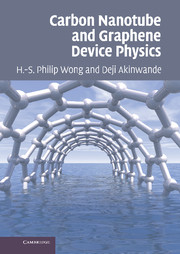Book contents
- Frontmatter
- Contents
- Preface
- 1 Overview of carbon nanotubes
- 2 Electrons in solids: a basic introduction
- 3 Graphene
- 4 Carbon nanotubes
- 5 Carbon nanotube equilibrium properties
- 6 Ideal quantum electrical properties
- 7 Carbon nanotube interconnects
- 8 Carbon nanotube field-effect transistors
- 9 Applications of carbon nanotubes
- Index
7 - Carbon nanotube interconnects
Published online by Cambridge University Press: 05 June 2012
- Frontmatter
- Contents
- Preface
- 1 Overview of carbon nanotubes
- 2 Electrons in solids: a basic introduction
- 3 Graphene
- 4 Carbon nanotubes
- 5 Carbon nanotube equilibrium properties
- 6 Ideal quantum electrical properties
- 7 Carbon nanotube interconnects
- 8 Carbon nanotube field-effect transistors
- 9 Applications of carbon nanotubes
- Index
Summary
If you build a ‘better’ mousetrap, you'd better know what the existing mousetrap can do.
Introduction
This chapter explores electron transport in metallic nanotubes as it relates to interconnect applications. Both single-wall and multi-wall CNTs are considered. The reader will find it beneficial to be familiar with Chapter 4, which discusses the structure of nanotubes, and Chapter 6, which explores ideal nanotube electrical properties, such as the quantum conductance, quantum capacitance, and the kinetic inductance. Employing CNTs as metallic wires to route direct-current (DC) and high-speed signals in an integrated circuit was one of the earliest application ideas promoting nanotubes because of their high current-carrying capability and ballistic transport over relatively long lengths. In this light, we will examine both the low-frequency (lossy) and high-frequency (lossless) transmission line models for single-wall and multi-wall nanotubes in order to elucidate their interconnect properties. These models include bias or field-dependent electron scattering in the nanotube vis-á-vis the mean free path. As such, electron scattering and mean free path will be discussed, although at a somewhat elementary level. Additionally, the temperature and diameter dependence of the electron mean free path and resistance will be highlighted.
At the end of the day, future nanomaterials such asCNTs have to be benchmarked against existing materials to quantify any performance benefits over conventional approaches. For this purpose, we will discuss the performance of CNTs compared with copper, which is the standard metal used in nanoscale integrated circuits today.
- Type
- Chapter
- Information
- Carbon Nanotube and Graphene Device Physics , pp. 157 - 190Publisher: Cambridge University PressPrint publication year: 2010



